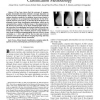Free Online Productivity Tools
i2Speak
i2Symbol
i2OCR
iTex2Img
iWeb2Print
iWeb2Shot
i2Type
iPdf2Split
iPdf2Merge
i2Bopomofo
i2Arabic
i2Style
i2Image
i2PDF
iLatex2Rtf
Sci2ools
TITB
2008
2008
A Novel Breast Tissue Density Classification Methodology
Abstract--It has been shown that the accuracy of mammographic abnormality detection methods is strongly dependent on the breast tissue characteristics, where a dense breast drastically reduces detection sensitivity. In addition, breast tissue density is widely accepted to be an important risk indicator for the development of breast cancer. Here, we describe the development of an automatic breast tissue classification methodology, which can be summarized in a number of distinct steps: 1) the segmentation of the breast area into fatty versus dense mammographic tissue; 2) the extraction of morphological and texture features from the segmented breast areas; and 3) the use of a Bayesian combination of a number of classifiers. The evaluation, based on a large number of cases from two different mammographic data sets, shows a strong correlation ( = 0.81 and 0.67 for the two data sets) between automatic and expert-based Breast Imaging Reporting and Data System mammographic density assessment.
| Added | 29 Dec 2010 |
| Updated | 29 Dec 2010 |
| Type | Journal |
| Year | 2008 |
| Where | TITB |
| Authors | Arnau Oliver, Jordi Freixenet, Robert Marti, Josep Pont, Elsa Pérez, Erika R. E. Denton, Reyer Zwiggelaar |
Comments (0)

